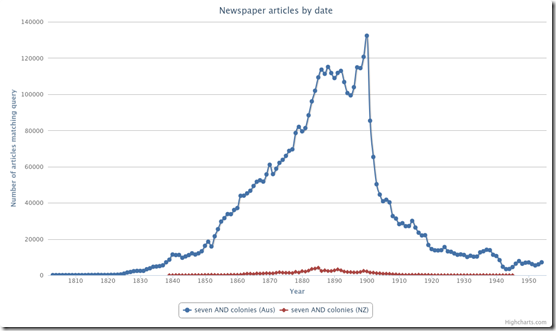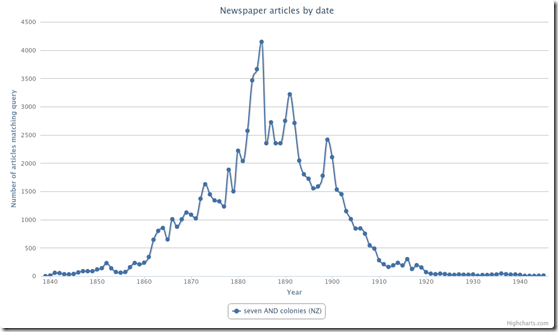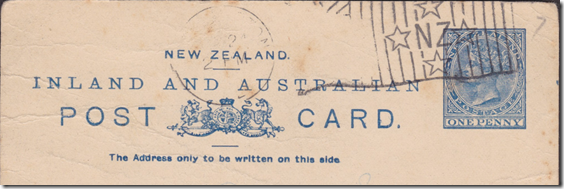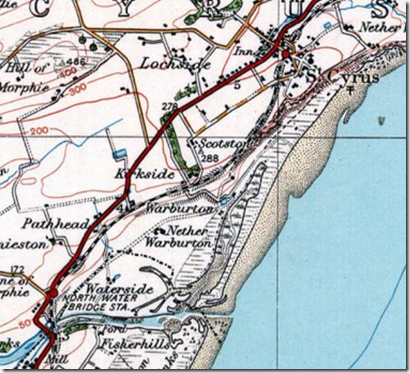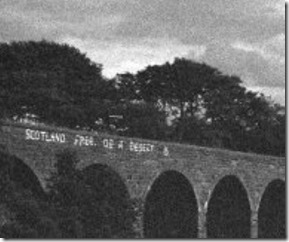Tasmania.
For reasons too complicated to explain in an opening paragraph, we were going to Tasmania for a few days.
I knew nothing about Tasmania – I had never been there and my ideas, such as they were, had been formed from a mixture of gardening and wildlife shows, a grim historical drama, and a couple of crime shows suggesting that Tasmania was the psychopath capital of the world and that you were likely to be dragged off at random into the forest to be murdered and disembowelled, and that your remains would never be found having been crunched into unrecognisable fragments by a horde of Tassie devils.
Nevertheless we went.
Driving off the overnight ferry in the early morning gloom to be confronted with a sign touting the Devonport Axe man Museum, I began to wonder if perhaps we might have made a mistake coming to Tasmania – maybe it really was full of axe murderers.
We’d hoped to find somewhere open for coffee and breakfast, but no, everywhere was closed so we drove on towards Launceston.
I remembered that I had made (and forgotten) a thermos of coffee for the journey before leaving home the day before, so we pulled off the Midland Highway at Westbury – a nice, very English looking place with a church on the green and normal people walking their equally normal dogs – not a psychopath to be seen, but who knows – we’ve all seen Miss Marple dramas and what goes on behind closed doors in quaint English villages.
We were in search of a toilet, and despairing of finding an open cafe, decided to stop to see if the coffee was still warm.
It was, surprisingly so, so we sat in the early morning chill on the green and drank our coffee, and munched on a couple of muesli bars. It might not have been the greatest breakfast in the world, but after having been woken at quarter to five to disembark from the overnight ferry, it did the job of making us feel human and that Tasmania might not be so bad after all…
So why were we in Tasmania?
A holiday. J had booked for a ten day artists workshop in Tasmania, but rather than fly there and back alone, we decided that we would have a few days in Tasmania before J’s workshop and that I would take the car back alone, along with J’s outdoor gear and anything else she didn’t need for the workshop, meaning that hopefully her luggage would come in blow Qantas’s 23kg weight limit.
So, off we went on the ferry travelling overnight. The whole overnight experience was not wonderfully comfortable, even though we’d booked a cabin.
When we were boarding we noticed that some travellers were taking their own pillows. At first we thought that an eccentricity, but the we discovered the provided pillows to be thin, as were the doonas. We ended up folding the single thin pillow provided over on itself to get something more comfortable – and I normally sleep with a single thin pillow.
Lesson learned – if we do it again pack an air pillow each.
So, after a less than restful night – being woken at 0445 didn’t add to the experience we drove on to Launceston where we were going to spend a couple of days.
We were of course far too early to check in to our hotel so we drove to George Town for brunch. No where was doing brunch so we settled for some chicken salad rolls and take away coffee and sat beside the statue of Matthew Flinders and his cat, and were promptly subjected to an attempted mugging by a local feline, who was prepared to fight off the seagulls if we dropped any chicken.
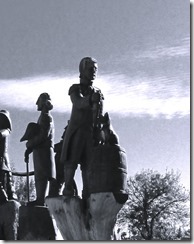
After our brunch of sorts we drove out to the lighthouse, and then back to Launceston to check in to our hotel and collapse for a bit after our early start.
The next day we explored Launceston and visited QVMAG – actually just the art gallery in the old building. The next day was simply hot, so we just walked round the waterfront and back through the town – and then we were off to Coles Bay for the weekend – it was the Labour Day weekend so the area was busy but we’d managed to book a quiet AirBnB a little bit out of town on an arm of the sea, and we birdwatched, walked on the mudflats and relaxed and read books one afternoon when it rained gently.
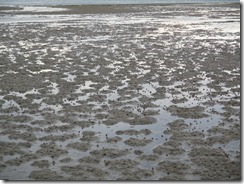
While it was still shorts weather it was noticeably cooler than Launceston – the weather was breaking us in gently for our next stop, Hobart, which was actually cold with a wind that came out of the Antarctic – that said we had a good time, visiting the Tasmanian museum and strolling around Salamanca and the waterfront. Our day in Hobart happened to be my 68th birthday, so we treated ourselves to a decent meal out.
Our final stop was Port Arthur, where again we had an AirBnB overlooking the water – loved the location but the weather was still chilly, and one night it had the impertinence to rain quite heavily, however the rain cleared in the morning, in fact our last day, when we had planned to visit the historic site.
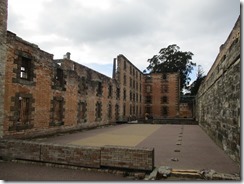
I was disappointed in the site. A little too Disneyfied for my taste with boat trips round the bay, and having seen Norfolk Island, I thought it a bit less interesting.
To be fair, it’s not totally the site’s fault. Abandoned in the 1860’s, apart from the Lunatic Asylum, the site was sold off in bits and pieces.
The main penitentiary was mostly destroyed in bushfires at the end of the nineteenth century, as were some of the other buildings that had fallen out of use. The staff and officers’ houses, which by then were privately owned mostly survived, but as they were people’s private residences they were inevitably chopped about a bit with a room added there, or a wall taken out to make a larger parlour.
The heritage people have been gradually buying back the properties and restoring them where possible, but they don’t quite have the feel of Quality Row at Kingston on Norfolk Island.
It’s not possible normally to visit the prison graveyard – the Isle of the Dead – although you can see it from the boat trip round the bay. Unlike Norfolk Island there’s no family history centre on site to help people researching any of their ancestors who might have ended up in Port Arthur.
Equally I came away feeling that they could have made more of the remains and the museum presentation could be better – for example what NSW have done with Trial Bay provides more historical information plus an engaging visitor experience.
That said, it’s worth visiting if you get the opportunity.
And then we were done.
A long drive to Winnaleah to drop J off, followed by another two and half hours to the ferry terminal.
Rather than another overnight sailing, I’d decided on a daylight crossing, which meant I needed to be at the ferry port by something like six thirty in the morning.
So, while it would have been nice to stay with J at the workshop for a night, it would have meant setting off at around three in the morning, I settled for a night in a motel and a microwave curry.
Driving towards Devonport as the sun was going down I was startled by something with three very bright lights coming towards me on the wrong side of the road – at first I though it must be some massive potato digging machine or the like, but in fact the railway line parallels the road in places and in fact it was a Tasrail freight train – well they only have freight trains in Tasmania – heading south.
The daytime crossing was tedious, in the way a long flight is tedious. I’d hoped we might see a whale or two, but no, all we saw was the ferry’s sister ship heading in the opposite direction. Mostly I contented myself with rereading Shōgun – an ideal book for a long journey and looking out the window.
The ferry was late in to Geelong, but it didn’t matter, I’d already decided not to drive back after such an early start, and had booked into a motel for the night.
The next day I was up before dawn to get clear of Geelong before peak hour started in earnest, and I had a slightly surreal experience.
I was sitting on the toilet and idly gazing out the window as one does, when a V/line commuter train went past about 50m away. The motel toilet window had one way film on it so it’s not as if anyone would have been able to see anything but it was odd to be sitting on the loo watching a train go by.
Then a long drive home, stopping to buy supplies at Wangaratta. The heat wave had begun to break but Wang felt steamy and humid, the way Bangkok or Singapore does after rain. I managed to beat the rain home and unload the car before it started.
The garden had suffered in the heat, but no irreparable damage…







